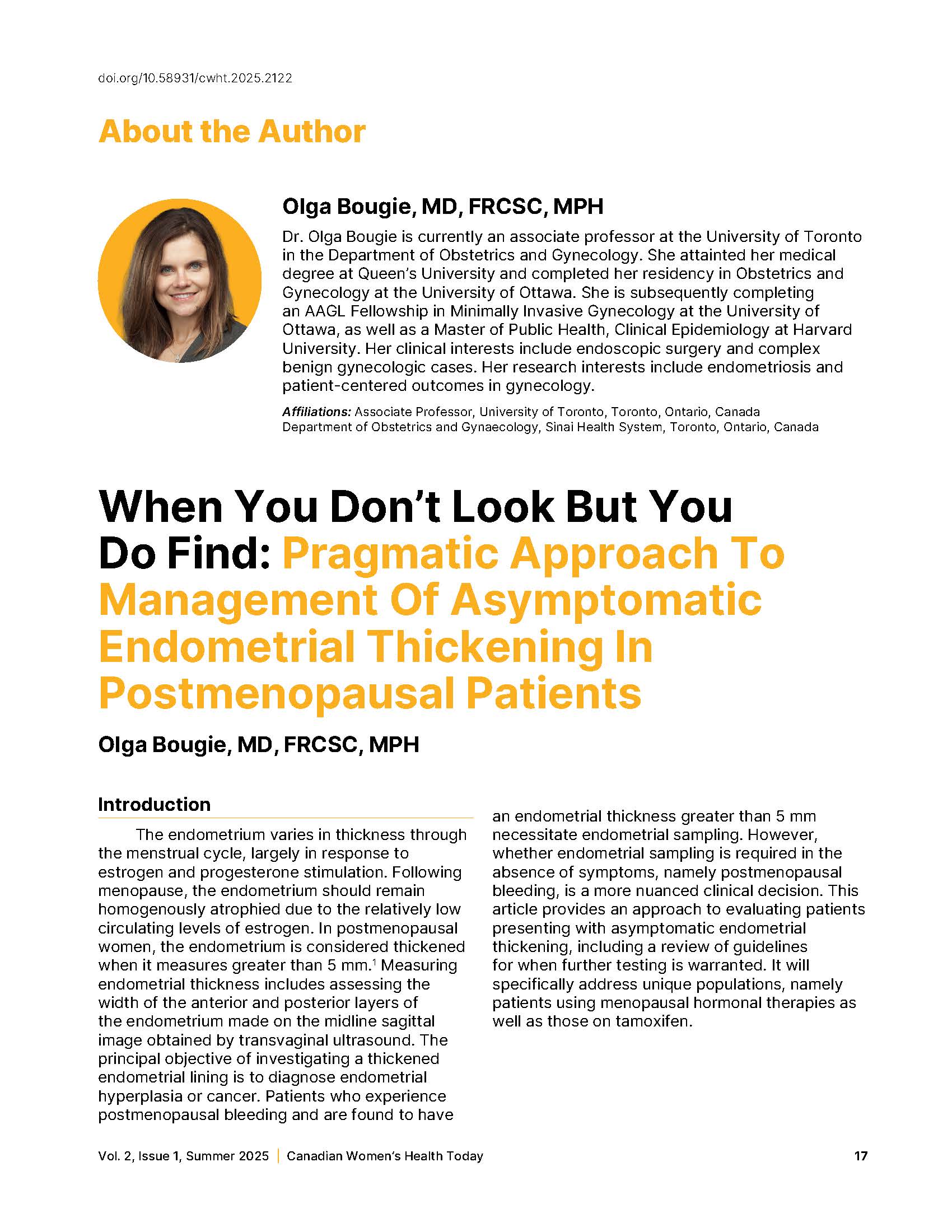When You Don’t Look But You Do Find: Pragmatic Approach To Management Of Asymptomatic Endometrial Thickening In Postmenopausal Patients
DOI:
https://doi.org/10.58931/cwht.2025.2122Abstract
The endometrium varies in thickness through the menstrual cycle, largely in response to estrogen and progesterone stimulation. Following menopause, the endometrium should remain homogenously atrophied due to the relatively low circulating levels of estrogen. In postmenopausal women, the endometrium is considered thickened when it measures greater than 5 mm. Measuring endometrial thickness includes assessing the width of the anterior and posterior layers of the endometrium made on the midline sagittal image obtained by transvaginal ultrasound. The principal objective of investigating a thickened endometrial lining is to diagnose endometrial hyperplasia or cancer. Patients who experience postmenopausal bleeding and are found to have an endometrial thickness greater than 5 mm necessitate endometrial sampling. However, whether endometrial sampling is required in the absence of symptoms, namely postmenopausal bleeding, is a more nuanced clinical decision. This article provides an approach to evaluating patients presenting with asymptomatic endometrial thickening, including a review of guidelines for when further testing is warranted. It will specifically address unique populations, namely patients using menopausal hormonal therapies as well as those on tamoxifen.
References
ACOG Committee Opinion No. 734: The role of transvaginal ultrasonography in evaluating the endometrium of women with postmenopausal bleeding. Obstet Gynecol. 2018;131(5):e124-e129. doi:10.1097/AOG.0000000000002631
Bougie O, Randle E, Thurston J, Magee B, Warshafsky C, Rittenberg D. Guideline No. 447: diagnosis and management of endometrial polyps. J Obstet Gynaecol Can. 2024;46(3):102402. doi:10.1016/j.jogc.2024.102402
Lee SC, Kaunitz AM, Sanchez-Ramos L, Rhatigan RM. The oncogenic potential of endometrial polyps: a systematic review and meta-analysis. Obstet Gynecol. 2010;116(5):1197-1205. doi:10.1097/AOG.0b013e3181f74864
Sasaki LMP, Andrade KRC, Figueiredo A, Wanderley MDS, Pereira MG. Factors associated with malignancy in hysteroscopically resected endometrial polyps: a systematic review and meta-analysis. J Minim Invasive Gynecol. 2018;25(5):777-785. doi:10.1016/j.jmig.2018.02.004
Rotenberg O, Doulaveris G, Fridman D, Renz M, Kaplan J, Xie X, et al. Long-term outcome of postmenopausal women with proliferative endometrium on endometrial sampling. Am J Obstet Gynecol. 2020;223(6):896 e891-896 e897. doi:10.1016/j.ajog.2020.06.045
Lu KH, Broaddus RR. Endometrial Cancer. N Engl J Med. 2020;383(21):2053-2064. doi:10.1056/NEJMra1514010
Clarke MA, Long BJ, Del Mar Morillo A, Arbyn M, Bakkum-Gamez JN, Wentzensen N. Association of endometrial cancer risk with postmenopausal bleeding in women: a systematic review and meta-analysis. JAMA Intern Med. 2018;178(9):1210-1222. doi:10.1001/jamainternmed.2018.2820
Segev Y, Dain-Sagi L, Lavie O, Sagi S, Gemer O. Is there a survival advantage in diagnosing endometrial cancer in asymptomatic patients? A systemic review and meta-analysis. J Obstet Gynaecol Can. 2020;42(4):481-487 e482. doi:10.1016/j.jogc.2019.04.020
Bhaskaran K, Douglas I, Forbes H, dos-Santos-Silva I, Leon DA, Smeeth L. Body-mass index and risk of 22 specific cancers: a population-based cohort study of 5.24 million UK adults. Lancet. 2014;384(9945):755-765. doi:10.1016/S0140-6736(14)60892-8
Li Z, Li L. Risk of malignancies among asymptomatic postmenopausal women with thickened endometrium: a cohort study. Medicine (Baltimore). 2019;98(6):e14464. doi:10.1097/md.0000000000014464
Wolfman W, Bougie O, Chen I, Tang Y, Goldstein S, Bouteaud J. Guideline No. 451: asymptomatic endometrial thickening in postmenopausal women. J Obstet Gynaecol Can. 2024;46(7):102591. doi:10.1016/j.jogc.2024.102591
Crane JMG, Craig C, Dawson L, O'Grady T, Bartellas E, Hutchens D. Randomized trial of oral misoprostol before endometrial biopsy. J Obstet Gynaecol Can. 2009;31(11):1054-1059. doi:10.1016/S1701-2163(16)34351-1
Perrone JF, Caldito G, Mailhes JB, Tucker AN, Ford WR, London SN. Oral misoprostol before office endometrial biopsy. Obstet Gynecol. 2002;99(3):439-444. doi:10.1016/s0029-7844(01)01742-2
Ghanavati M, Khorshidi Y, Shadnoush M, Akbari ME, Ardehali SH, Chavarri-Guerra Y, et al. Tamoxifen use and risk of endometrial cancer in breast cancer patients: a systematic review and dose-response meta-analysis. Cancer Rep (Hoboken). 2023;6(4):e1806. doi:10.1002/cnr2.1806
Bertelli G, Venturini M, Del Mastro L, Garrone O, Cosso M, Gustavino C, et al. Tamoxifen and the endometrium: findings of pelvic ultrasound examination and endometrial biopsy in asymptomatic breast cancer patients. Breast Cancer Res Treat. 1998;47(1):41-46. doi:10.1023/a:1005820115535
Cohen I. Endometrial pathologies associated with postmenopausal tamoxifen treatment. Gynecol Oncol. 2004;94(2):256-266. doi:10.1016/j.ygyno.2004.03.048
Committee Opinion No. 601: Tamoxifen and uterine cancer. Obstet Gynecol. 2014;123(6):1394-1397. doi:10.1097/01.AOG.0000450757.18294.cf
Furness S, Roberts H, Marjoribanks J, Lethaby A. Hormone therapy in postmenopausal women and risk of endometrial hyperplasia. Cochrane Database Syst Rev. 2012;2012(8):CD000402. doi:10.1002/14651858.CD000402.pub4
Pinkerton JV, Harvey JA, Lindsay R, Pan K, Chines AA, Mirkin S, et al. Effects of bazedoxifene/conjugated estrogens on the endometrium and bone: a randomized trial. J Clin Endocrinol Metab. 2014;99(2):E189-198. doi:10.1210/jc.2013-1707
Crandall CJ, Diamant A, Santoro N. Safety of vaginal estrogens: a systematic review. Menopause. 2020;27(3):339-360. doi:10.1097/GME.0000000000001468

